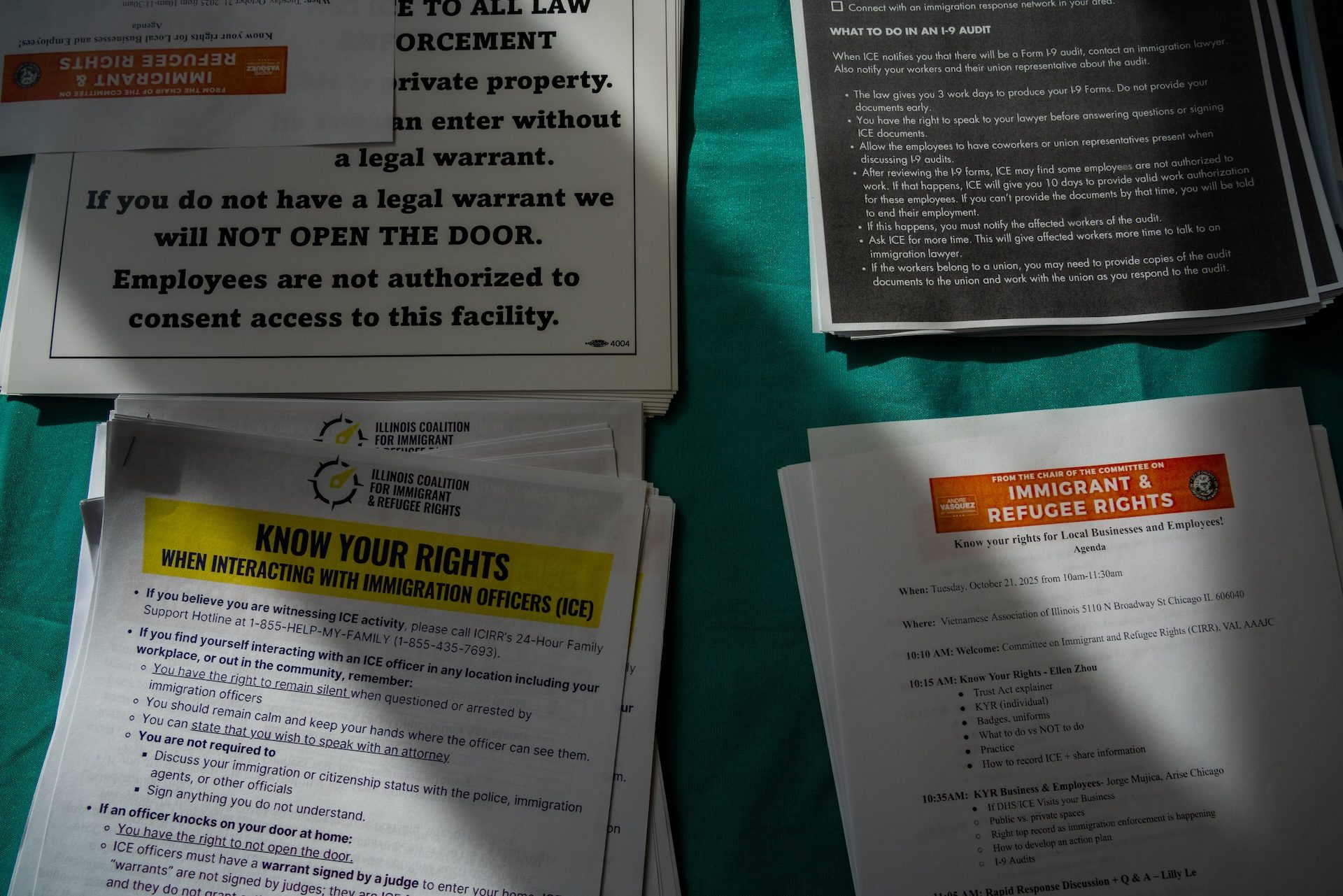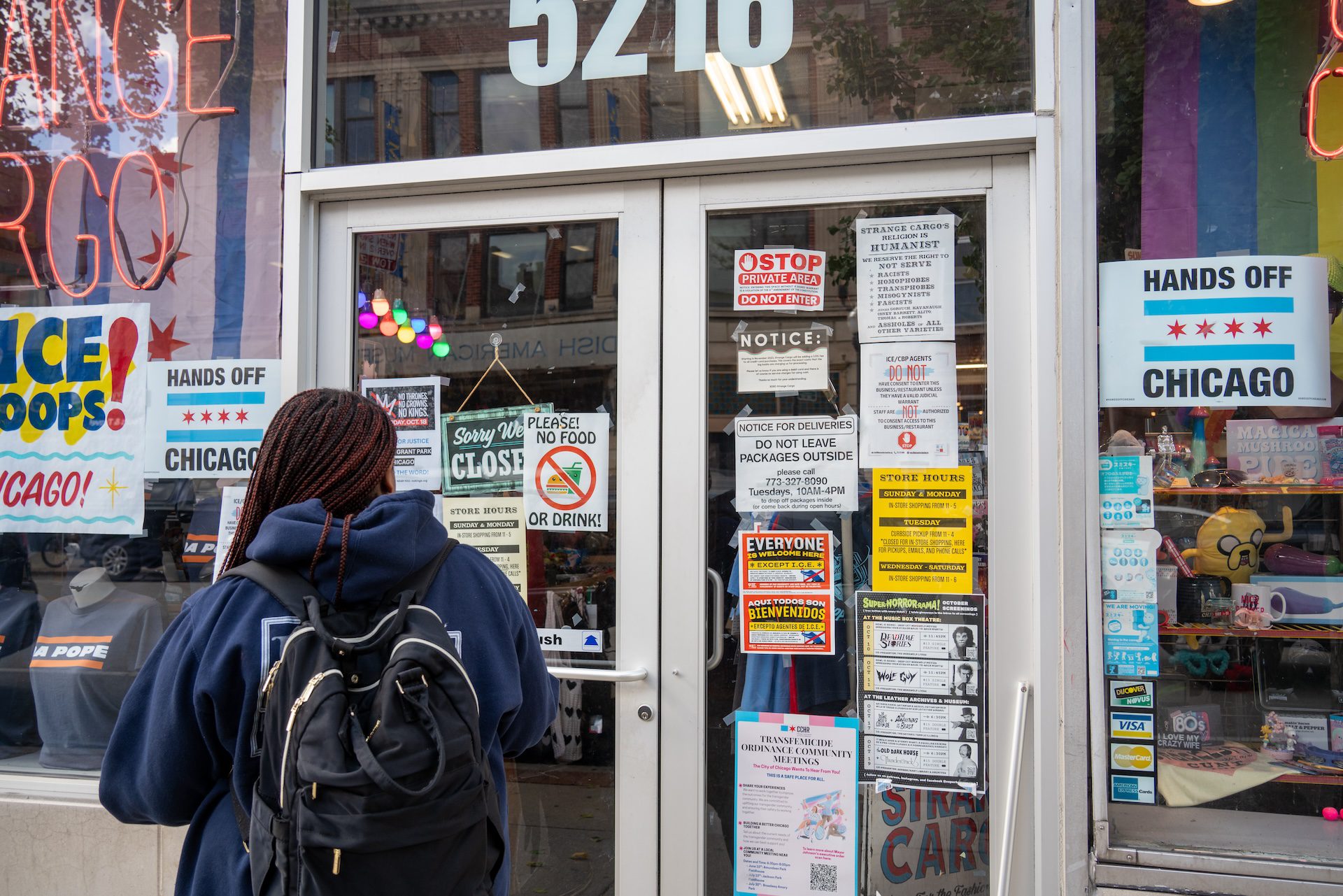 Camilla Forte/Borderless Magazine/Catchlight Local/Report for America
Camilla Forte/Borderless Magazine/Catchlight Local/Report for AmericaThe Trump administration’s immigration crackdown has small business owners and their employees navigating uncertainty amid safety concerns and staffing shortages. Borderless Magazine compiled a guide on what to do if ICE appears at your workplace.
In recent weeks, reports of Immigration and Customs Enforcement (ICE) raids in Chicago’s South and West Side businesses have raised safety concerns among immigrant workers and employers.
Federal agents have targeted restaurants and small businesses for immigration enforcement, with back-to-back raids in neighborhoods with high immigrant populations, including Little Village, Pilsen and Belmont Cragin as part of “Operation Midway Blitz.” Federal agents have deployed tear gas, smoke bombs and used other increasingly aggressive tactics against construction workers, street vendors, journalists and elected officials.
Business owners and employees have said the heightened immigration crackdown has left them on edge, worried about possible ICE presence.
News that puts power under the spotlight and communities at the center.
Sign up for our free newsletter and get updates twice a week.
“It’s horrible for business,” said Jay Schwartz, the owner of Strange Cargo. “It’s horrible for the community. It’s horrible for everyone. We are trying our best.”
In response, businesses like Strange Cargo, a custom t-shirt store in Andersonville, said they’ve taken a stand against heightened immigration enforcement, with owners putting up signs on their storefronts emphasizing that ICE is not welcome. Meanwhile, other businesses have taken additional measures to protect residents from encountering a federal agent by keeping doors locked and only opening them for each individual guest.
Despite these efforts, some business owners are left wondering what else they can do and how they should react if ICE steps into their business.

Borderless Magazine spoke with legal experts and some immigrant rights groups, including Arise Chicago and Asian Americans Advancing Justice-Chicago (AAAJC), to compile a guide to help employers understand what jurisdiction ICE has over businesses, how to protect their employees and how to navigate ICE encounters.
Can ICE agents enter my business?
ICE agents can enter public portions of businesses, including dining areas, parking lots, lobbies and waiting areas, according to the National Immigration Law Center.
However, ICE agents cannot enter private areas — like private offices or break rooms — without permission unless they have a judicial warrant. A judicial warrant is a court order signed by a judge, authorizing the search or arrest of a person with probable cause that a crime has been committed.
Immigration law experts recommend that if ICE presents a judicial warrant, employers should check that it:
- Has the correct address;
- the correct name and spelling;
- the correct dates; and
- is signed by a judge.
If ICE agents have an administrative warrant — which federal agencies issue to arrest someone whom they suspect of violating immigration laws — it does not give ICE permission to enter private areas.
To identify administrative warrants, look for a heading stating the agency and a signature by an immigration officer.
If ICE enters my workplace, how can I respond?
Employers and workers have the right to speak to a lawyer before answering questions or signing ICE documents.
Law experts say being in a public area does not give ICE the authority to question or detain anyone without probable cause or a warrant.

If ICE comes into your workplace, the National Immigration Law Center recommends that you:
- Have a written response plan ahead of time;
- Practice what to say and do;
- Train staff not to talk to ICE agents or lead them to any workers; and
- indicate private areas using signs and by locking doors.
If ICE agents try to stop, question, detain or arrest a worker:
- Employees should stay silent and ask for an attorney, and
- they do not have to hand over any IDs or papers.
During an I-9 Audit, ICE requests to check work authorization of employees. If asked, employers should deliver only I-9 forms and will be given three work days to produce them. They can also ask ICE for more time to prepare and allow some employees to speak with an attorney.
Workers and employers should stay calm and never run during an ICE raid, according to immigration law experts. They should pay attention, and potentially record, the ICE agents’ actions in case they violate workers’ rights.
Anyone in the United States has rights guaranteed by the Constitution. (Read our guide on the rights all people have, regardless of status, here).
How do I document an ICE interaction?
Everyone has the right to film or photograph law enforcement or ICE agents in public spaces and on their own property.
Immigration law experts recommend recording the activity while maintaining a safe distance. However, they advise that bystanders should refrain from physically intervening to avoid escalating the situation.
“People should feel completely entitled to record what they’re seeing and share that recording,” César Cuauhtémoc García Hernández, law professor at Ohio State University, told Borderless Magazine in September.
The Illinois Know Your Rights Taskforce, a coalition of immigrant rights groups, also recommends using the SALUTE method when documenting an ICE interaction or raid:
- Size: How many agents or officers are present?
- Activity: What are the agents doing?
- Location: What specific address, intersection or neighborhood is this interaction happening?
- Uniform: What details or patches can be deciphered from the agents’ uniforms or jackets?
- Time: What exact time did this interaction happen?
- Equipment: What materials did agents have with them?
Share any recorded information with the proper rapid response network, and reach out to the Illinois Coalition for Immigrant and Refugee Rights (ICIRR) family support network and hotline to report any suspicious ICE sightings at 855-435-7693.
This article is for educational and informational purposes only and should not be construed as legal advice.
Tara Mobasher is Borderless Magazine’s newsletter writer and reporter. Email Tara at [email protected].
Aydali Campa contributed to this report.

